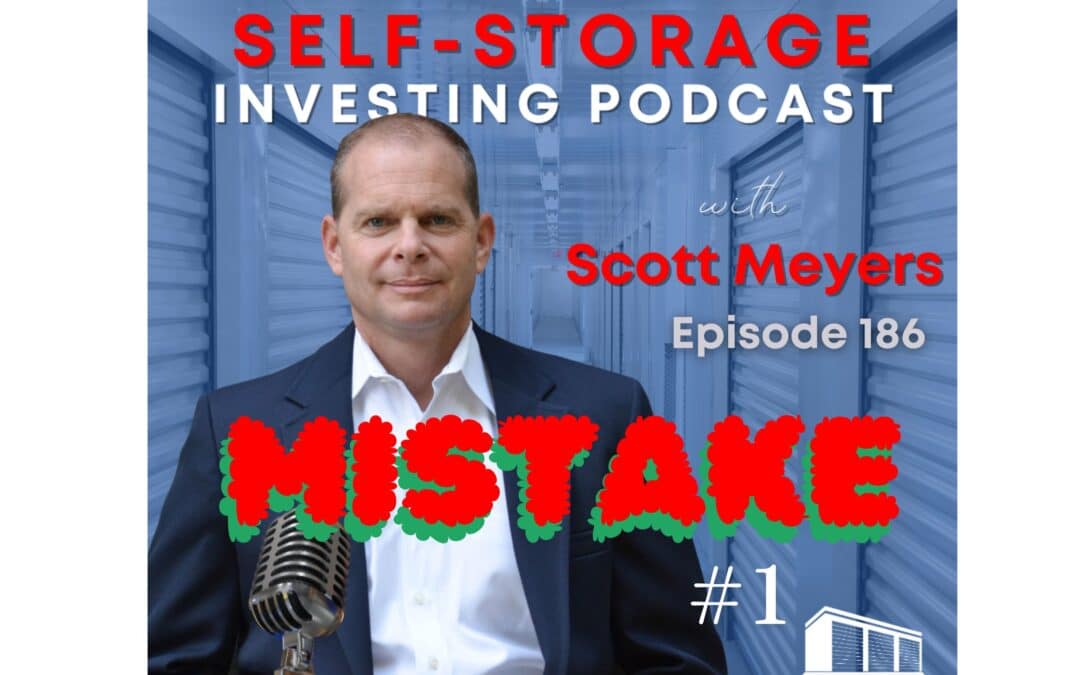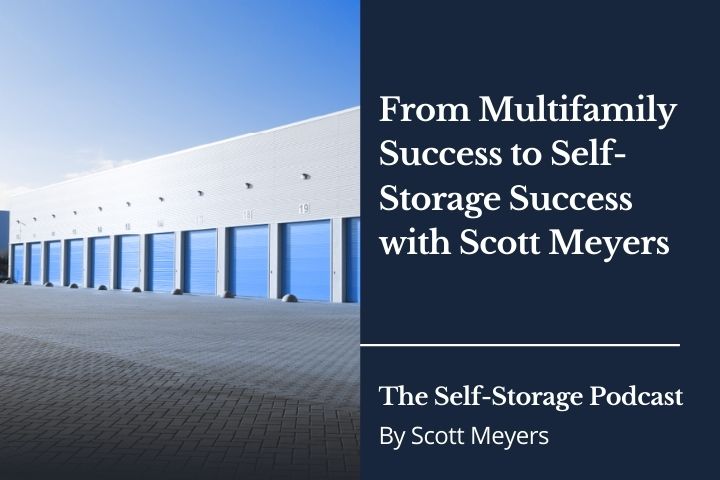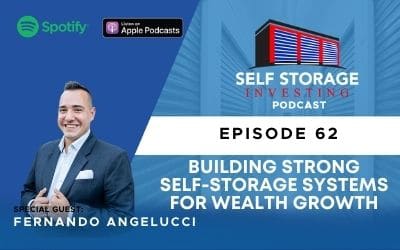Ever wondered what could derail your self-storage investment before you even start?
Scott shares his personal blunders and lessons from over 20 years in the self-storage business, providing vital advice on how to avoid costly errors.
He highlights the critical importance of location, market analysis, and thorough planning.
WHAT TO LISTEN FOR
04:44 Market Analysis: Key Factors to Consider
15:02 Retail Mindset in Self Storage
20:19 Supply Index and Market Demand
25:36 The Role of Feasibility Studies
Leave a rating for this podcast with one click
CONNECT WITH US
Website | You Tube | Facebook | X | LinkedIn | Instagram
Follow so you never miss a NEW episode! Leave us an honest rating and review on Apple or Spotify.
Episode Transcript
Scott Meyers (00:00):
Hello everyone and welcome to the Self-Storage Podcast. I’m your host at Scott Meyers, and I am excited because today we are going to embark upon a journey. So we’re going to do a series of episodes on, well, we focus so much on the success and the successful ways and the ways that people can become successful in self-storage. But what people ask for many times is what are the mistakes? What are the pitfalls? How can I get tripped up? What could potentially take me out of the game before I even get started? And so although our focus around here is one of abundance and of success, we are also not blind to the fact that there are people out there that are making mistakes and big mistakes. And sometimes, and I mean this in a kind way, it’s out of ignorance. And just because they haven’t spent the time to dig into and understand from experience what this looks like, and to have those mistakes and to get a number of years under your belt, having learned them firsthand, but also educating yourself.
(00:57):
And so that’s where we come in. We are investors, we are educators, we are syndicators, we are developers, we are all things self-storage, including operators. And so what we’re going to be focusing on in the next several episodes with a few others have peppered in are the mistakes, mistakes that I’ve made in the past in my 30 years in commercial real estate and now approaching 20 in self-storage. We’re going to be open and transparent, and I’m going to share some of the mistakes that I’ve made from blind spots to just flat out blunders to some other gotchas that were just unforeseen. And I can’t even say there were mistakes because we felt that we had done all of our homework and that we had mitigated all of our risk only to find out that, wow, this is something that was unforeseen. So is it really a mistake?
(01:43):
Well, I don’t know that it’s necessarily a mistake other than some of the things that can happen, but the mistake may be that we just didn’t account for that, maybe in a budget or recognizing that every project that we take on, whether it’s an acquisition or a development, has something that may be unforeseen that’s going to trip us up. And just the fact that we come into it, assuming that everything’s going to go well is a mistake in itself. And so what we’re going to focus on today is starting with one of the most basic tenants of investing in real estate, which is the big three location, location, location that is going to determine more than all other factors combined that is going to determine whether your project is going to succeed or not. And that includes an existing facility, even though we’re looking back historically, but more importantly in focusing on a development site or a project that you’re going to purchase, a building that you’re going to purchase and then convert into self storage as well.
(02:37):
So we’re going to approach it from that standpoint, and that is, is this site, is this market good enough to support my next step project or the current project, which also may help you to understand why the project may be struggling or suffering to begin with, is because somebody decided to build this facility in a location, in a market, in an area of town that was destined to maybe not reach its full petition to begin with. And so we’re going to cover this in detail today. And so I welcome you to come along on this journey where, yeah, we’re going to open the kimono and we’re going to begin to share the mistakes that not only that I’ve made but other investors have made along the ways, but how do we mitigate those? And more importantly for you to take notes and even through, not through your own experience but through our experience, be able to build up that situational awareness and so that when you come into a site, even if it’s something that you see that you haven’t experienced on your own, that hopefully you can draw from. Oh, I remember the podcast where Scott was talking about this happening, that happening, and I remember the story that he told about that challenge that he had with one project that looks very similar to the one that I’m looking at right now. So to keep you from falling into the traps or the pitfalls or some of the landmines that we navigate as we go about our day in investing in self storage. Okay, so with that, without further ado,
Announcer (03:57):
This is the Self-Storage Podcast.
Scott Meyers (04:04):
So a couple of ways of approaching the market when looking to invest in Self Storage. So whether it’s existing facilities that you’re looking to acquire or if you’re looking into development to and or both as you come into a market, we typically look at the deal first and then we back into the market to determine whether it’s something that we want to invest in. But then if we’re looking at development in general, well then that’s what we’re looking at first obviously is the market. We want to know that the site or the area that we’re looking at and the path of progress on the way out of town on the outskirts, where the growth is occurring or where the sewer lines are being laid as we say, how is this going to work and what are the markers that we look at that determine what is a truly good site to be able to build on?
(04:44):
And if there’s an existing facility that we’re looking at, what makes this market good right now and in the future? And so for the most part, what we’re looking to develop, it begins with, well internally our own data and our own research. We have a number of data gathering partners that we utilize to pull reports that show us what the market looks like in terms of a demographics, in terms of a growth, in terms of population, median income, traffic count on the road. There’s a lot of information that we can pull that make up a successful site, which we’ll touch on in a minute that we can do internally. But when you’re first starting out and even as you become more seasoned and as a veteran, we’re still going to consult with the consultants, we’re still going to consult, we’re still going to employ the consultants to bring in the reports and their data sets and their experience on top of all the reports that they purchase and data that they spend money on as well, which is far more vast and greater than ours.
(05:35):
But then for them to be able to tie that all together with their experiential knowledge as well to say, Hey, we deem this as an a plus site or a B minus site, and here’s what you can expect in terms of a lease up and a performance because the market is either an a plus or a B minus, and not all markets are created equal. So let’s start with location. Location. The physical location of a facility isn’t important as it used to be in the past, and I’m just going to start there by saying we like an a plus site, which means that it has a high traffic count, it’s on a corner, it’s in the path of travel for whoever is going to be utilizing the storage unit, which typically in a typical household, if you want to call it a mother father household, it’s usually mom that is going to be running her husband’s stuff over or her extra stuff or the kid stuff or the holiday stuff over into the unit.
(06:24):
For a business, obviously exposure and a high traffic count, if it’s a business use, it is important to be in the path of travel, which means it doesn’t, we don’t want it to be located in the back of an industrial zone with a lot of one-way streets and not visible and also doesn’t have good ingress, egress or entry or exit upon the facility itself. And so we want the site to not only be visible to everybody, but it is critical that we perform a market study to determine all of these factors. And so whether you’re doing this out yourself or whether you’re hiring a consultant to do a feasibility study for you on a development site or just on a market study from to find out why is this existing facility that we’re looking at only 50% occupied or 60% occupied after seven or eight years?
(07:11):
Well, it could be that the market is oversupplied. Maybe it isn’t a market issue at all and it is an operator issue, but that is why we studied the market to determine whether it is feasible in order for us to be able to build a facility here at this particular site or in this market or that we’re going to be able to achieve the returns that we had anticipated or expect out of this new acquisition that we’ve identified that we are pursuing right now. So a number of things that we want to look at in terms of, and I’m going to go back and forth as we look at a site, talking about a development as well as acquisitions because a market is a market whether we’re looking to develop or if there’s an existing facility, but there are some things before we head into a market that we want to be able to consider.
(07:49):
And one of those is if it’s a development site, what are the zoning and planning considerations? And I don’t mean what is it currently zoned for? I mean marching into the zoning and planning office and having a discussion with them showing interest in a particular part of town or a particular parcel and stating that here’s our intention that we’re looking to build a self storage facility on the site we see that is already zoned for storage or that it’s not, but we’re looking for and we will be seeking a variance. And so we would like to know what is the city’s appetite? What is these zoning boards, appetite for self storage? Can you tell me about the projects that have been put forth? Have they been turned down? Have they been met with a lot of scrutiny? Have they been met with a lot of monstrous from the neighborhoods?
(08:31):
Is the city pro storage? In other words, they understand and they recognize the need for it and the service that self storage hub provides and it’s part of the overall planning strategy. Or do they simply state that we don’t want them doors, the nimbyism not in my backyard. We don’t want them doors. We don’t want what self-storage brings to our city. And so if anybody wants to store anything, want to be, we want to just, they can store it on the outskirts of town, but they’re not going to store it in my city. And those are exact comments that I’ve heard from some of the city planners and some of the zoning boards as well. So it’s important to know what is the appetite of some of these zoning boards and the planning commissions as it relates to storage so that you know if you’ve got an uphill battle ahead of you to get approved or especially if you’re going to ask for a variance because you may not get one at all.
(09:18):
We bought a piece of ground that was a commercial project and there was storage within the town limits, not much, but we just felt that it was going to be a natural because this building had been vacant for several years. It was an eyesore, we’re going to convert it and that the city would love for it to be converted to self-storage and made into a beautiful gleaming shiny class, a self-storage facility, multi-story in a good part of town only to find that yes, those comments were made is that if somebody has that much stuff, they need to throw it away or if they want to store it, they need to store it and the outskirts because we’re not allowing anymore. Well, to our surprise, we had to do a little finagling, but those are some of the considerations that you need to keep in mind when you are embarking on a project and that it’s not an automatic that the city, the zoning board is going to be on board and that the planning commission is just going to rubber stamp up your project.
(10:10):
So not only do we need to understand exactly what this project looks like, but then also if we are going to be relegated to a different part of town, you still like the market, but now you’re going to be sent to outside or only sent to the industrial parts of town. Well, are you already out located by existing players or is everybody in the same boat right now? Could you be out located already before you even get started or what are the chances that somebody else may be able to snag a better site depending upon where it is that you’re looking within the city? And we don’t know that for certain, but the best way to be able to find out is to have those conversations by marching into the zoning and planning commissions and having those meetings with them. Also, site size is clearly a consideration, whether it’s an existing facility, can you expand?
(10:59):
Does that meet the goals of your project, our goal and whether it’s for ourselves or for our equity partners as to we need to be able to double the value of this facility within four to five years. I mean, that’s kind of a starting point for us, especially if we’re bringing private equity partners in. There just isn’t enough returns to go around. If we don’t have a substantial increase in valuation of this facility, then we won’t be able to afford to bring in partners to provide the equity needed on top of the loan to be able to make this a successful project. So do we have room to expand If it’s a development project or an existing building or warehouse that we’re looking to convert, well, is it big enough to be able to put enough square footage onto rentable square footage onto this piece of dirt or inside of this building to make it worthwhile to be able to handle a management company, managers on site and the overall costs that are needed to run the facility?
(11:54):
Will it generate enough income to be able to afford to operate in a manner in which all of those expenses are covered so we don’t have to piecemeal or have somebody part-time or that the owners themselves or you have to participate in a portion of the operations because well at a 5% or 7% or 9% management expense ratio, well, we can’t really just afford this, doesn’t throw enough income to be able to afford to have a management company third party operate this, and so we’re going to have to figure out a better way to do this. That starts with size and how many square feet and how many units can you put onto this site or into this building to make it feasible to cover the basic operating costs without a lot of input from you or hiring maybe some substandard part-time workers to be able to manage this asset for you?
(12:37):
What are the next considerations is then the cost of a development in a particular area, in a particular market. And this could mean a lot of things if we’re starting with a piece of ground, a piece of a dirt, if you will, what’s it going to cost to be able to get the site ready to be able to build on? It doesn’t have a slope. Have you had an impact study done in terms of a geo study done to determine what’s underneath the ground? Is there something underneath there that is buried some old construction materials, some old farm materials, some underground tanks of some sort? What was here before? What’s there now? How far down do you have to be able to dig to get to bedrock, if you will? How far down do you have to dig to get to some solid ground to put footers in?
(13:19):
If you’re going out, multi-story, how far down can you go to or do you have to strip the land to be able to get level ground or do you have to build it up and bring dirt in and build a retaining wall? All considerations in terms of the site, going back to the size again and how we’re going to plot the units and the footprint of this facility. Where does the water drain? Does it slope off already naturally or do we have to put an underground drainage system in? Can we just slope the units and place the buildings in a place in a manner in which the water is not going to run into the buildings? There’s a lot that needs to go into the site, and that means bringing out a civil engineer to determine and lay out just exactly whether this site is going to work or not to determine how many pads can I put on this site to be able to create a large single story facility taking into consideration the easements as well as water retention.
(14:19):
So all of this to say before we dig into even more of the details, in an ideal world, we’re looking for an a plus site and an a plus market. Sometimes the strength of a site can overcome the weakness of a market and sometimes the strength of the market can overcome the weakness of the site as well. But that’s why we need to dig into and look at, check all the boxes and look at all of these considerations before moving forward, especially with a development project, but also with an existing facility if we’re looking to expand or if we’re looking to take it to the next level and double the value. And I think one of the mistakes that people make is they do not look at self storage as if it’s a retail business. It is commercial real estate with a retail and operating business on top of it.
(15:02):
So you’ve got a propco and an Opco, so you’ve got a property company and you’ve got an operating company two separate, and I think many times real estate investors coming from other asset classes, they make the mistake of looking at self storage as just another asset class in commercial real estate, but it has an operating component to it as well. And so it is considered a retail business. And so for a good retail business to be able to survive, most customers want their store to be close to their home. Most people want their stuff to be close to their home as well. So if you’re looking at developing a site as we touched on earlier, or if an existing facility is really back off the beaten path, it is not in the path of travel or in the path that anybody who is going to want to stop by, drop something off or pick something up out of their facility, they’re going to have to really work at it to be able to get to that site.
(15:49):
Or it’s just not top of mind because nobody ever sees it because nobody ever drives past it because it’s not in a location that is considered a retail location with a high traffic count where people see on a regular basis. So when they’re looking for storage and they look online that they remember, oh, I remember where x, Y, Z storage is, it’s the one with the red doors and it’s on the way to school and I see it every day when I drop the kids off or it’s close to church or it’s on my way to my knitting club, whatever that may be, is it close to home and is it in the path of a travel for folks or is it just off the beaten path and really hard to be able to get to? And so again, I think many people make the mistake of compromising and they say, well, this site is off the beaten path a little bit but not too far and it’s not too difficult to get to.
(16:31):
It’s cheaper than this great retail location over here. It may even be a little bit smaller than the bigger one that I wanted over here, but I think this is going to work just fine and I’ll make it all work because we’ll have stronger ads online and draw more people in. You always need to be thinking about the end in mind and with the end in mind, it means that you’ve got a budget, you’ve got a pro performer that you need to meet and you need to put yourself in the best position to be able to lease this facility up as quickly as possible to be able to meet your budget, meet your projections not only for yourself but for your lenders and for your private equity partners that may be coming alongside of you as well. So this is not an area in which you turn a blind eye and once again, try to put a square peg in a round hole.
(17:09):
And I could say that make that statement for just about any of these mistakes that we’re going to talk about is that I think as an investor who is looking to get into their first and many times their next on a project, they get a little over anxious and they may not like what they see in the marketplace, and so they begin to compromise, compromise, compromise, compromise to get into their first deal until the excitement of just doing a deal trumps the viability because they compromise so much that now they put themselves in a position in which the facility is either destined to fail or it’s not going to meet its projections because we’ve compromised so much. So don’t fall into that trap. It should be the opposite. You want to put yourself in the best position to be able to succeed because everything happens faster and if you put yourself in a better position than what you had anticipated getting into begin with.
(17:55):
So always opt for the better site, the better location in the better market. We also find that if it is a better site, a better location, potential customers choose. As we’ve seen from studies over and over again, they choose a particular site because in quotes, I saw it, they remember going past this site. And so don’t underestimate the strength of a location because it is on a road with a high traffic count because it is top of mind for folks. And so you need to consider that for years the number has always been 10,000 plus cars per day. I would state that you can get by with less than that. As a matter of fact, we have very successful sites that have leased up very nicely and right on track and right on path with those facilities that do have 10,000 plus or more car count per day.
(18:42):
And that is because people are looking online for storage and as long as it’s close to where they live, the website looks nice and clean and secure and it isn’t tucked way back in an industrial part of town that the site will succeed and it will be successful. It doesn’t have to be on a major road, but you do need to consider the traffic counts. And if it is way off the beaten path, well then that’s one that just pass on. I walk on next. Access is key. As I mentioned before, one-way streets are not conducive for storage or any business for that matter, retail business restaurants that is basically a no-no and a death sentence. And so we don’t want to be on one-way streets unless you happen to find a great site that is located in a very large major metropolitan statistical area and you happen to get it, then that is expected and anticipated.
(19:29):
But in a normal setting, in a primary or a secondary city, you’re not going to find a lot of one-way streets. And so visibility is key for what we just mentioned earlier and that is top of mind, so it should be visible and that’s the way you can also draw attention and some additional traffic to your site is if you have banners and flags that catches the attention in the eye of your potential customers even now or in the future. And then we want to look at a relation to the competition. So without going into the intricacies of a full-blown market study, you just need to be aware that there’s competition around and once you do your supply index and your market studies, this does pertain to location, but more on the market study side, what is the supply index within a five mile radius equilibrium always being somewhere between six and a half to seven and a half square foot per capita.
(20:19):
Now we’re seeing other markets that fall outside of that, meaning usually a site in which the market is showing six and a half to seven and a half square foot per person. And when I say a market meaning in a five mile trade area, five mile radius, that’s roughly equal everywhere supply meets demand. However, when I say that doesn’t always hold true, it’s because we have purchased sites. We have built in the locations of which there are nine to 10 square foot per capita, but the demand is much higher because there’s a lot of multifamily. There’s a high concentration of multifamily and mobile home sites and housing that does not have a lot of storage or zero lot lines or very few garages or no basements in terms of a Florida, which basically has a river running underneath it or sandy soil markets in which there aren’t basements and places to store where there’s heavy restrictions and moratoriums on storage and sheds in people’s backyards. Those areas we may find 9, 10, 12 square foot per capita, but everybody, the competitors or the facilities in that location, they have a waiting list because there’s still such a high demand. And so there’s a supply index factor and there’s a demand factor. And so how are we poised? Are we close to our competition? Is there too much competition?
(21:36):
Can we out manage them? Can we out market them? Do we have a better product that we’re going to build or what we’re going to do with this existing site that we’re looking to bring online and we’re going to convert this either a building or we’re going to take this existing facility to the next level and add all the amenities and now it’s going to be the nicest, it’s going to be the bell of the ball in the market. How do we stack up compared to the competition in terms of a proximity from a pricing standpoint and also from a logistics standpoint as well as a curb appeal standpoint as well. Now, when we look at neighborhoods as it pertains to storage coming out of habitation real estate, we’re going to look at this a little bit differently. We’re not looking for the best school systems to put our self storage facilities in because we don’t have any kids in our storage facility.
(22:21):
They’re going to be going to school. We’re not looking for it to be quiet because it could be next to railroad tracks. As a matter of fact, some of our most successful sites have been right next to railroad tracks because nobody else wants the ground. And so it’s very cheap. So it is that good for self storage. You bet. You bet it is because we can stretch those buildings all along the tracks. We can pennies on the dollar for that land. It’s easy to access and it just works out well for self storage. And so we’re almost looking for the opposite of what will be a very promising site for habitation because they’re going to pay a premium for that. However, we are going to dig into the demographics of the neighborhood. It can’t be a demographic in which we find that it is an extremely low income neighborhood because in that case we don’t have as many clients that have well additional disposable income to buy more stuff, to be able to store more stuff and then have the disposable income to pay for that stuff on a regular basis.
(23:17):
In other words, if people don’t have a couple of nickels to rub together, they’re not going to amass a lot of stuff to be able to put into storage and then to be able to pay for it. And so we stay away from the extremely low income neighborhoods. Is crime a factor? Well, it is. It typically goes hand in hand with a facility that is in decline and that has low income as well. If there are a lot of break-ins and there’s a number of different websites in which we’ll cite that, we tend to look at what is the crime in a particular area and really what we’re looking for is the crimes of opportunity. We’re looking are there a lot of thefts and burglaries in a market? And if that is the case and if it happens to be an existing facility that we’re looking at, we can pull the police runs from a site, request ’em from the police department and also from some of these other websites that we subscribe to find out have there been runs specifically to this particular self storage facility so that we know is there a problem here and or other locations.
(24:11):
If it’s a site that we may be looking to develop in, we’re going to look at the police runs and the overall crime level if there is an activity within a five mile trade area to determine whether this is a site that we want to go to because if people don’t feel safe going into a business in that area, well then we don’t want to be in that area as well. So on the positive side, what we’re looking for is new development. We could be going into a market where as I mentioned that it could be 8, 9, 10 square foot per person, but what is the development pipeline that also are, those are also the questions we’re going to ask when we go down to the zoning department, which is, Hey, we’re interested in this part of town. What kind of growth is coming down here?
(24:51):
Are there new permits being pulled? Are there new developments that are coming online that you can talk about or that you can share? Or are there lease in consideration in the works? And where are those from new housing subdivisions to new apartments if there are mobile home parks being considered, assisting living? All of those generate a need for storage and we want to know what is coming into that market and there are ways that we can find that out ahead of time before we decide to pull the trigger on an existing site or on a development site. Now, before we embark upon a development site, we are always going to pay for and solicit the services of a consultant to perform a feasibility study to determine if the site is feasible or not. Is that feasible to build? What we propose is a 100,000 square foot multi-story class a facility at this location.
(25:36):
And within that feasibility study, we’re going to get the rental rates in the market, which is most important. We’re going to get the supply index, which is as we discussed before, the amount of square footage per person in this market. We’re also going to get a development budget at today’s cost, so what it’s going to cost to build it. And then projections, budgets, performance if you will, that shows the timeline of how much it’s going to cost to be able to build this site, the site work, the construction itself, what are the rental rates, what is the speed at which we feel we’re going to be able to lease this up? When is it going to reach optimization? In other words, 85 to 90% occupancy and all of the concessions of the specials have burnt off. And when do we project that we could sell this or refinance it and what would the cap rate be and the valuation at that time?
(26:21):
So that is the type of detail and the level of detail that a consultant is going to provide in a feasibility study that’s going to cost anywhere from three to five to seven to perhaps $10,000 to perform depending upon what it is that you’re looking for and how complex your site and your development project is going out to be. And when we raise capital, as we do for a number of our projects on developments and conversions, and we are always performing a feasibility study, and we will work with that consultant as well to determine what is the true number of competitors, what is the true square footage because we’re gathering data as well. And I think one of the mistakes that I see many new investors, many new developers make and when they step into a project is that they buy the cheapest study they can from a very inexperienced consultant and then they just assume and they take at face value the report that comes back to them.
(27:14):
And I think that’s probably natural for people to do as well, but we take a different approach that we’re performing it on our own in-house gathering the same data, and we’re digging in a little bit further because I want to know what developments are coming, if they missed and if they grabbed every single facility in the market and was it accurate in terms of the square footage that they have? There are some folks that’ll do a desktop study, consultants and companies that’ll do a desktop study, but they may look at self storage from Google Maps and determine and draw the lines around the buildings and gits. Google Earth Pro has some amazing tools, but then they determine here’s what the amount of square footage is in the market, but they fail to really come down to well street view and determine that the footprint is actually three levels.
(27:56):
And so there’s triple the amount of square footage and oh, now we just found that this is an oversupplied market, so we will go the extra mile. We’re always looking for facilities that don’t show up on Google Maps. It’s kind of the lazy way of looking at all the facilities because not all going to be located there and also then determining what is the actual population and is there any growth coming? So there’s a lot more homework and information that goes into a feasibility study or truly a market study to determine if a site is feasible more than just what you’ll get from the consultants. Now, for the consultants that are listening and for you that are going to share this with your consultants, we love our consultants. I’m not beating them up and I’m not saying that what you get isn’t useful at all.
(28:34):
It’s that we have a very good relationship and a partnership with our consultants that perform these feasibility studies, and that means that we help them by bringing the data that we have into their data resources so that not only when they’re doing their study for us, but also for future clients that they’ve got a full data set that they can work from as well. And so we work hand in hand alongside of them because in this, for the same reason, which is to build a successful site and for them to be able to put forth a study which led to if it’s a very successful site because they gave it a thumbs up, a green light or they labeled an A or a B plus site and they allowed, which allowed their clients to move forward in and it came to fruition. That only helps out all of us to raise all boats when the tide is going up because all of us are contributing to it.
(29:22):
Also, another piece that consultants bring to the table is they have the details on a particular market and they may already be in those markets investing with other folks. Yes, some of these consultants invest with others, but they keep tabs on these markets. And so they have the additional data to know how long does it take to fill up, develop a 1000 home subdivision, and what percentage of households rent storage space in this particular market. So they have that market specific data that if you’re heading into a new market or if you’re new to self storage that well that you just may not have that experience. And so again, I see the mistake that so many investors make is that they don’t bother to take these things into consideration or they grab some averages or heaven forbid they use chat GBT to be able to create some answer that makes them check the box and move on and go forward.
(30:13):
Okay. Now another one of the mistakes that we see people make is when it comes to zoning and planning. And so we’re going to dig in a little bit further here. And first of all, if you’re considering a site, it has to be commercial, most likely it needs to be industrial if it is not properly zoned. And if you’re looking to get a variance, you need to step into the office and ask them those questions about the likelihood of getting a variance or having it to rezoned for self storage before you purchase a site. And I would say one of the mistakes that I’ve seen other folks make as well is that they just have this entrepreneurial optimism that they’ll get it done and they bought a site even against their attorney’s advice and only to find that they couldn’t get it zoned. And the zoning board said, Nope, we now have a moratorium on storage.
(30:58):
And so you cannot use it for that purpose or we’ll get you to this place, but it doesn’t allow for self storage. It doesn’t allow for going to three stories high as your plans allow for, which means that we’re only going to allow you to build single story, which means multiple buildings on multiple pads, and now you’ve ended up at a fraction of the size of facility that’s really not going to work for this land that you just have paid for. So this entrepreneurial optimism as you head into a development project or a conversion, you need to make sure that you have, I would say, plans in place and have the existing owner if possible, go through that process with zoning and planning and not purchase it until you have made sure that you are secure, that you can follow through and go forward with the plans that you have in place for the site.
(31:44):
And also ask how long that is going to take. So if there is a process in which you’re going to have to have it to rezoned or get a variance, well, how long does this typically take? Well, you don’t know unless you ask. Tell me about some of the other projects that you have had in place that have been rezoned for any purpose, but have you had some that have come through this office that have been rezoned for storage? What does that process look like and how long did it take? Because if you’re adding this to your overall project timeline and the equity that you’re going to have to raise or the money that you’re going to have to borrow from a lender or other source to be able to account for this lengthy development phase until you get to the place where it is cash flowing, and if you haven’t allotted for another six months to 12 months to get it through zoning and in the meantime you have to pay taxes on that dirt and also on the loan that you took out to buy the land, well then you may leave yourself a little bit short and above all else.
(32:32):
Don’t assume a commercial looking, a commercial looking in air quotes, for those of you that are listening, a commercial looking site allows self storage. You may have to get a special use permit. It can be very restrictive in terms of the height, landscaping, the size of buildings, sprinklers, signage. Many times what you’ll hear for each one of those proposals that you put in place are the plans and the renderings that you bring into the zoning and the planning board for approval are met with no and modifications each and every step of the way in terms of the overall height. Landscaping requirements can be very egregious. The size of buildings, what needs to be sprinkled. This has killed some projects in terms of a fire suppression signage where they allow none or if they have to, if you are required to put a six to eight foot tall block wall all around the entire facility, that is an expense that you didn’t expect because you are planning to put in either chain link, depending on the part of town that you’re in or the market or the very least a raw to iron fence around it.
(33:30):
Now to find at all buildings that are coming up into this market or just for self storage, they want you to put up a split block wall all the way around it so that nobody can see those doors, which is the best advertising for your facility. Many of these things can be deal killers, but if they add three, four or five of these to a project and put them in as stipulations, it could definitely spell death to your property before you even get off the ground. Then yet another one of the mistakes that we see so many people make is once they have developed this site or they have acquired their new site, they didn’t really plan on the exit. They didn’t have an exit strategy in mind. They didn’t know how long it was going to take to be able to lease this up or turn it around and what year they were going to be in when this was completed and optimized and stabilized and what the interest rate environment may look like.
(34:18):
I mean, we’re always looking at if it’s a four to five year project, we’re looking where we are right now. We know that there’s typically a seven to 10 year cycle in terms of recessions and interest rates. And so where are we going to be on that spectrum? Are we going to be in a rising interest rate environment and therefore lowering the valuation of our facility when it’s time to sell? Or are we poised and planning to hold this until we reach the bottom of this cycle, which means that interest rates are the lowest and now we’re going to be heading back into a recession? And so now is the optimal time to sell and have we modeled this out in terms of our budget, our performance, and our projections to appropriately sell at the right time? And timing is everything. And that factors into all of the discussions that we just had in terms of the timing of an exit, but also leads us into the operational and management expectations of this site.
(35:11):
How are we going to manage it? What is the best management structure for this site? And I know we’re talking about site specific, but it is site specific. How big is this facility is going to determine how we’re going to manage it, the exit strategy, what the budget will allow? All of these are considerations when it comes to picking a location if the existing facility or the development is located in a tertiary market as opposed to working in a primary metro area. Most folks are used to working with technology and a kiosk in many different settings and many retail settings. All of these are considerations with regards to the market and what the market will bear and what the market will be amenable to with regards to your operations. So as I begin to summarize what it looks like, you’re seeing a common theme here, and that is that you do need to have a market study that is done.
(36:00):
At the very least, this is going to help you to assemble your own thoughts. And we do, again, a lot of this in-house, but when you get a market study back from a consultant, you’re going to look at all the considerations that they take into consideration as to whether a site is a thumbs up or a thumbs down or a well, it may take a little while to achieve your projections and the returns that you would like, but we’re not going to tell you not to build this site. It’s going to give you the framework and the ability to look into all of these areas at which you should be looking into to consider a site for development or for acquisition. And at the end of the day, don’t do it yourself. It’s really easy to do this on an existing facility. You can just look at some of the numbers, talk to the broker, talk to the lender, the appraiser, and if everybody says it’s okay, well it may be okay and you may not step into anything.
(36:48):
I would say that you’re still going to need to lean in a little bit further. And when it comes to a development site or a conversion, the same rule applies. Don’t do it yourself, but I think you’re going to be hard pressed to get a lender or private equity to give you money just because you put together a PowerPoint and talk about all the reasons why this facility is going to succeed without the hard data from an independent third party company slash individual or a consultant that doesn’t have a stake in the game, that doesn’t have a dog in the hunt or any other financial benefit other than getting paid to do the report, to put forth any kind of a glowing report that is going to make a lender want to lend and private equity to want to pour into your deals. So you are going to be raising capital and asking for a loan from the data that has been gathered and provided in a feasibility study.
(37:36):
Just there’s just no bones about it. And if the lenders and private equity is giving you money without it, I think that leaves you open to some liability. And I’ve seen that that mistake has been made by some folks where then it didn’t perform and the lender and the private equity partners are coming after this developer and they want their head on a platter because it doesn’t perform. It hasn’t performed anywhere near close to their projections. And that’s because they weren’t realistic and they put together their own report without somebody independent coming in to keep them accountable to say, well, here’s some things to consider and our projections aren’t as glowy as yours. As a matter of fact, here’s what we think are the real numbers. So for those reasons and many others, we’re going to do a feasibility study internally, but that doesn’t mean that we’re going to do it in exchange for something that we’re going to purchase from a consultant that is out there in the market.
(38:27):
That is, again, non-biased and independent. I also see some folks that get a very attached or too desperate to a site work in terms of an attachment. Well, they found one, they found a site in a city in which there’s very little land, there’s very few four to five acre parcels or three acre parcels that allow you to go up. And so since they found it, it means that it was meant to be and it’s destiny and it’s fate and they beat their competition to it. Well, no, it doesn’t mean any of that. It means that you found a potential opportunity but will determine later through a feasibility study whether it is actually a deal or not in terms of this land or this existing building or a site. You may own a piece of land that it was inherited. And so you’re attached to it that way to just say, well, you know what?
(39:12):
My grandfather gave us this land and it was meant to put an automotive dealership on it, but we think self storage is going to be better or it is a zone for a dairy queen, but we’re going to put self storage on it. And so we feel they’re very similar business models. And so this is going to work or as we mentioned time and time again, a mistake that many people make is that they let the excitement of doing a deal trump the viability of it. And so you get the feasibility study back from the consultant and it’s a c plus site. Well, by God, you’ve always been a hard worker and pull up your bootstraps kind of guy and that’s how you’ve made your previous businesses work or that’s how you got your job right now, or that’s how you’ve achieved anything in life.
(39:53):
And so by she hard work, you’re going to make this site work well, it doesn’t really work that way. And so we can’t get too desperate or too attached to a site if this study says or if the information that you’re gathering shows that it’s not going to work, then the best cook in the world can’t fix a bad recipe. So you need to make sure that you do your homework and pick the best site to put your best foot forward as well. And that means having somebody with no financial motive to see that the site does or does not work to guide you. Another mistake that I see people make in terms of a new development is that this is very short-term capital intensive. And so putting together a proper construction budget as well as a lease up budget is key. So it first starts with the construction budget, and I think sometimes the developers, meaning the development company that is coming alongside of the investor, allows the contingencies to be even lower to be able to get the job and to make the project work.
(40:53):
And if there are some things, some prizes that come up along the way, well, we’ll just make that up in change orders. Well, that is a horrible way of going about a development project. And you should also allot for and borrow or take on more private equity, borrow more money from the banks and bring on more private equity to make sure that you have a very lengthy runway to be able to account for all the contingencies and for a slower than anticipated a lease up. Because the last thing, you want us to run out of money before you have stabilize that facility or met your objective in years past pretty common it against 65, 70, 70 5% loan to cost loans to be able to develop a facility. Now we’re seeing that back down to 50% and 60% for more of the savvier developers that have a strong track record, which means that you’re going to have to borrow more money from either yourself, put in more of your own money or bring in more private equity, and that money costs more than a loan.
(41:46):
And so it puts an excess burden on the project. And many new developers and syndicators aren’t able to be able to raise that much money. And so they left themselves short. And once again, we know that you need to have enough capital to get these to the finish line, to get them to stabilization in order for a project to work. And those that feel as if they can outperform the consultants projections or again by hard work, they’re going to make this lease up faster while they fund themselves without enough money to be able to see the project through and they have to sell it short or short sale it, unfortunately, and that is not a position that you want to be in. And we’re seeing that those projects coming into the market right now, I feel that one of the mistakes that folks now make as well is that there are, the lenders are also going to ask for higher equity thresholds, meaning you have to have not only those supplies in place and deposited in order to be able to make those lease up reserves, but they’re also going to require you to have liquid reserves on hands at all times.
(42:43):
You need to show a proof of liquidity of a half a million or a million dollars that they were going to request on maybe every six months to see, Hey, do you have that $500,000 available just in case things go south? That may be a covenant that is part of the loan that shows that they’re going to ask for that and you need to provide that. And if you don’t have it, they may call the loan due. And in addition to that, you need to brace for the lease up. And because that is a high end capital intensive reserve that you need to keep in place because it’s going to go out the door pretty quickly once you are up and running in a development project or a conversion, you’re paying for the insurance, you’re paying for property taxes and payroll and utilities and all those costs with a very low to no income in the beginning.
(43:25):
And so you do need to brace yourself to see that money going out the door without the proper reserves and being accounted for in the first place is a daunting place that I don’t want to see any of you to find yourselves in because there are lots of moving parts of these projects and there is a very little room for error. So all that being said, this is not designed to, this series is not designed to get everybody pumped up and excited to race out the doors to get into self storage, although you still should be because of this asset class is not absolutely the best asset class to invest in all of commercial real estate and bar none. However, it doesn’t mean that you go out there with unbridled optimism and begin throwing around dollars and offers out of a place of ignorance. And when I say ignorance, again, folks in a very kind and loving way with all peace and love, make sure that you are preparing yourselves by looking at and running out all the scenarios and all the traps.
(44:21):
But that is what we’re here for. We are the only educators on the planet in self storage that have been through three recessions, that have seen just about all the mistakes out there because we’ve either made them or we’ve walked alongside of our students, our partners, our joint venture folks, and the other folks that we rub shoulders with in the industry that have shared their war stories and horror stories about things that have happened. And so this is the place, and we are the resource for showing you not only how to succeed in self storage, but how to avoid the pitfalls and the mistakes. And so now we’re going to be doing a deep dive. And so yes, I am excited about this to make sure that all of you not only survive the battles, but win the war and it is a war out there at times as well. So with that gang, I’m looking forward to our next session and digging in, well, the next most prominent mistake that we see self storage investors make, but more importantly, how to avoid ’em. So Storage Nation, you’ve been spending time with Scott Meyers. It’s been an honor and a pleasure to be with you. So stay tuned for the next session as I will share the second most prominent mistake that new self storage investors syndicators and developers make, but more importantly, how to avoid it. We’ll catch you on the next one. Take care, folks.
Announcer (45:35):
Hey gang. Wait three things before you leave. First, don’t forget to follow the Self Storage Podcast and turn on your notification so you never miss another episode. And while you’re there, please leave us a five star review if you like the show. Second, be sure to share your favorite episodes and more via Instagram, and don’t forget to tag us. And lastly, head to the links in the show description and hit follow on Twitter and Facebook to get a front row seat as we grow and scale our business and bring you along with us.
















